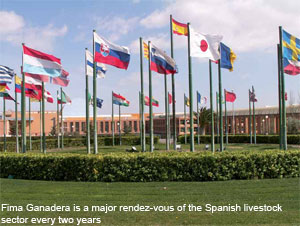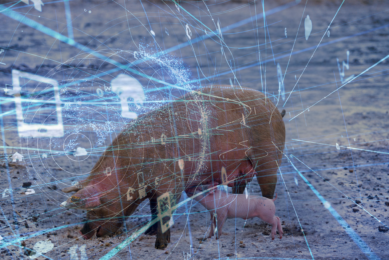Feed industry well presented at Fima Ganadera

The Fima Ganadera has become a major event of the Spanish livestock production. For the 9thedition, which took place in Zaragoza from 24 to 27 March, feed was well represented with rather positive exhibitors, in spite of the crisis in Spanish dairy and pig farming.
The recent Fima Ganadera was the opportunity for numerous exhibitors to present their products and services to the (Spanish) market.
From a total of 16 technical innovations, two were associated with feed: a hydrolysed beer yeast from the Spanish company Andres Pintaluba and an analytical system for the quantitative determination of the carotenoids from DSM Nutritional Products Iberia.
Among the French companies exhibiting in Zaragoza, Celtilait presented its range of products for dairy or small ruminants (lambs, kids). “The small ruminants market has been increasing for years while dairy farmers have to face economical difficulties,” said Claude Dezalys, commercial director. Active in Spain for 20 years, Celtilait is one of the current leaders for calf feeds. “Our target is to develop our Celtilait brand even if we mostly work with distribution brands today,” adds Dezalys who diversifies his activities with health products sold on the Spanish market.
For French company Provilys, founded in March 2009 following the merger of the service activities of Centralys and Celtic, it was the first official presentation under this new name. “Centralys has been present in Spain for 15 years where it exports from France technical products mainly for pigs and cattle,” explains Xavier Dugenetais, commercial engineer Provilys. The company exports to Spain pre-starters and starters for piglets, products such as the Cmax 3 have been sold in Spain for three years. “We mainly work with the Spanish feed producers and we are on a difficult market,” said Marc Soreze from Provilys who emphasises the importance of “technical products answering to the market demands”. Also present was the leader in Spain for piglet feeds, Ingaso Farm. Created in 1980, the company started to export its additives in 1997 and the recent opening of a plant in Alava in the North of Spain has boosted the sales for export. “Our target is to increase our export sales from 35% now to 60% in five years,” said Pilar Ochoa Olarte, managing director of Ingaso Farm, which exports to numerous countries, but mainly South America and Asia (Philippines, Thailand, Vietnam).
| Fima Ganadera exhibition of Zaragoza The 9thedition of Fima Ganadera took place from 24 to 27 March in Zaragoza, the main city of the autonomous Community of Aragon, located North-East of Spain, 300 km from Madrid. With a total of 810 exhibitors coming from 24 countries, the show registered 30% foreign exhibitors, the remaining being Spanish. All the livestock sectors were well represented on a total area of 75,000 m2, including a presentation of the Spanish cattle and sheep breeds. One whole hall was dedicated to feed and animal health. More than 140 foreign delegations came to Zaragoza, mainly from South American countries, but also from Hungary, Jordan, Lebanon, Morocco, Romania, and Russia. According to the organisers, 55,000 visitors were present in Zaragoza, 10% more than the previous edition in 2007. More info can be found at www.feriazaragoza.es/Fima_Ganadera.aspx |
Spanish feed market in decline
Official statistics published in March 2009, showed livestock feed production dropped in Spain by 2 million tonnes in 2008 compared to 2007 (Table 1). With a total compound feed production near 20 million tonnes per year, Spain is still a major European feed producer, close to the French and German level.
The drop in feed production is particularly severe for pigs (minus 600,000 t in one year), due to the decrease in pig numbers. Following the last census of the Spanish Ministry of Agriculture, the total number of pigs dropped by nearly 6% between August 2007 and August 2008 to 25.4 million pigs. The only stable category was for pigs from 80-109 kg. “The number of sows has dropped by 8% in one year, mainly in the Centre and in the South, and we are in a difficult market”, says José Angel Pedrido Rey, veterinary of the Dutch company Hypor, specialised in pig genetics. The pet food sector seems an exception with a steady growth to almost 700,000 t in 2008.
Five regions dominate and concentrate 75% of the total feed production: Catalonia (6.3 million t in 2007), Castilla and León (3.4 million t), Aragon (3.2 million t), Galicia (2.4 million t) and Andalucía (1.8 million t). In terms of pig production we find the same concentration with four regions (Catalonia, Aragon, Castilla and León and Andalucía) representing almost 70% of all the pigs produced in August 2008.
909 companies in 2008
In the Spanish enterprises directory INE (DIRCE), Spain counted 909 feed producers in January 2008. Of this total 327 have less than five employees, only 47 companies have more than 50 employees, while 123 companies have 20-49 employees. “The concentration of feed production is rather high”, states Cesfac (Confederation of Spanish feed producers) in its strategic survey published in November 2008 (Table 2). The six enterprises producing more than 700,000 t have a total production almost equivalent (35.5% of the total) to the production of the 868 enterprises producing less than 100,000 t.
According to Cesfac, the two largest producers represent 17.2% of the total turn over of the sector, with the first five representing 31.6% and the first ten 42.4%. Six companies produce more than 1 million t, the leader being Nanta with over 700,000 t of compound feed production per year. A subsidiary of the Dutch Nutreco group, Nanta has 15 plants in Spain plus one in Portugal, and also participations in other companies such as Arprisa, pienso Nanfor, and piensos Nanpro. In Spain, Nutreco also owns Sada, the main Spanish poultry company which acquired the poultry division of Conagra (2000), Agrovic piensos (2001), the Copaga cooperative, Trouw Nutrition España (specialties) and the pig integrator Inga Food SA (Table 3).
The 100% Spanish group Valls Companys, is in second position with a total feed production representing 7-10% of the total Spanish production. Valls Companys owns 12 companies in Spain in several branches: feed, poultry and pig integration, pig and poultry slaughterhouses, bread flours, a veterinary and pharmaceutical laboratory, logistics.
Nuter Iberica, originating from a merger between the Pascual group and the financial company Mercapital, holds third position with a share of a little more than 6% of Spanish feed production. C.A. Guissona, in fourth position, is a cooperative whose major feed production is dedicated to its own calves, poultry and pig integrated farms.
Cargill España, fifth in line, is a major raw material importer, with 14 feed plants in Andalucía, Extremadura, Madrid, Castilla and León, Galicia, Asturias, Murcia and Baleares, as well as Portugal. To complete the picture; Coren a cooperative located in Galicia but also active in other regions such as Castilla and León and Extremadura is a leader in meat production.
Coren has about 10 companies and most of its feed production is for its own needs (only 20-25% is sold on the free market).
Imported raw materials
Spain has a traditional lack of grains and oilseeds, which is a major handicap for the feed industry compared to its European neighbours. The country has an average annual grain production of 20 million tonnes, but with great variations due to the climate (from 13 million tonnes in poor years to 24 million tonnes in top years). Grains are very often grown in dry areas and yields are directly linked to weather conditions.
A little less than 12 million tonnes of grain have been imported during the 2007/08 campaign, of which maize (6,4 million t), wheat (2,7 million t), and sorghum (2,5 million t) are the main grains. On a total apparent consumption (production plus imports minus exports) of 27,7 million t of grain for the 2007/08 campaign, barley and maize are the main grains (9,4 million t each), followed by wheat (7,7 million t) and then oats (1 million t).
According to official statistics published by the Spanish Ministry of Agriculture in January, the drop in winter grains (from 2 to 12% compared to last year depending on the crop) may create a pressure on raw material availability in 2009. The drop is expected to be high for soft wheat (-12% to 1.3 million ha), but less grave for barley (-6.8% to 3.2 million ha).
There is also an expected drop in oilseed crops, with for example a 13.5% decrease forecasted for rape in 2009 compared to 2008. The analysis of raw material needs of the Spanish feed industry (Table 4) shows an increasing consumption of grains and cakes, and moretapioca also being imported since 2005.
*Philippe Caldier is a freelance writer who regularly contributes to Feed Tech.











